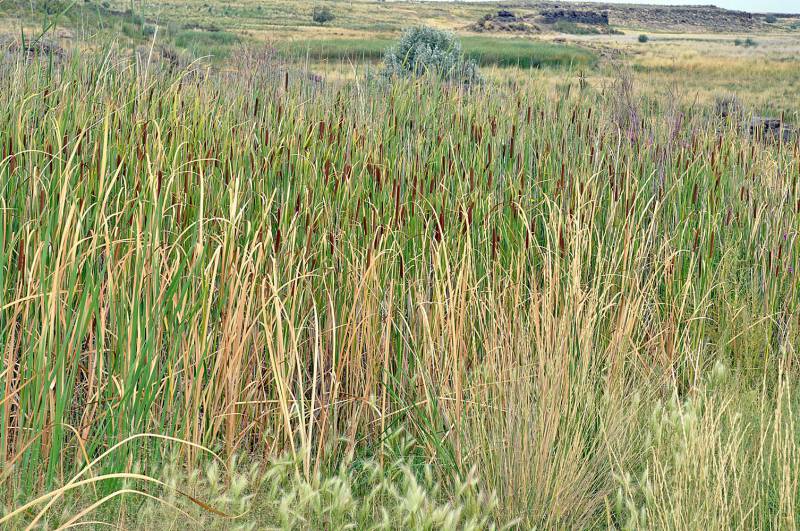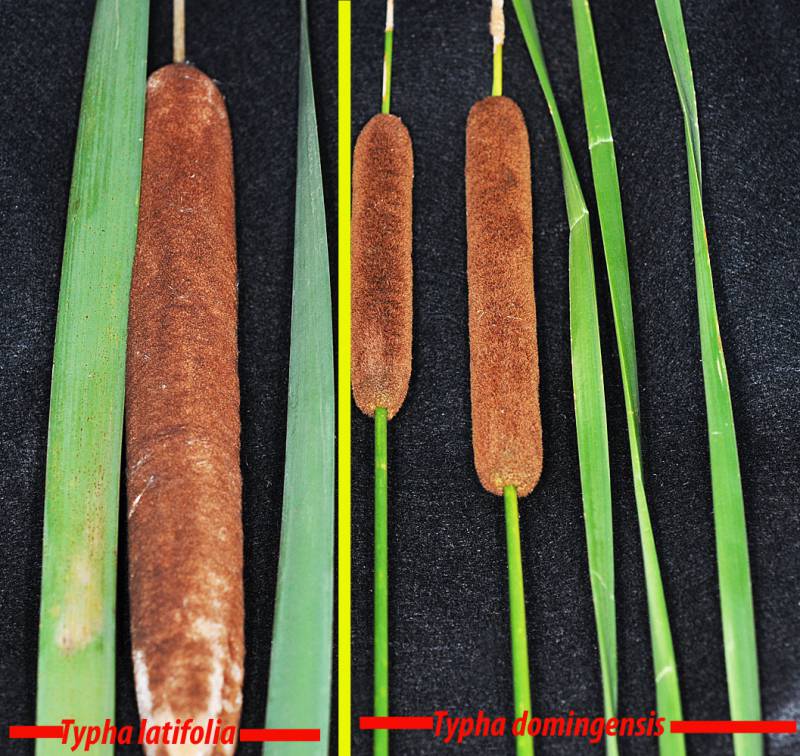Nonnative and hybrid cattails identification and control
Information about the noxious weed group, nonnative and hybrid cattails. Nonnative and hybrid cattails are also known by their Latin names, Typha angustifolia, T. domingensis, and T. x glauca. This includes any other nonnative Typha spp. This does not include the native cattail, T. latifolia.
About this weed
Nonnative and hybrid cattails are a non-regulated Class C noxious weed. This means due to how widespread it is, property owners are not required to control this species on their property, though it is encouraged.
Nonnative and hybrid cattails are also known as Typha angustifolia, T. domingensis, and T. x glauca. This also includes any other nonnative Typha spp. This does not include the native cattail, T. latifolia. They belong to the cattail family, which are sometimes referred to as reeds.

Why it’s a problem
Cattail can alter marsh habitat and infest valuable aquatic areas. They can grow aggressively and displace the healthy native vegetation by growing monocultures (areas with only one species of plant).
Invasive cattail species can also hybridize with native cattail stands which changes the genetic profile. This can be problematic, as the hybrid plants can be heartier and more difficult to control.
Plant description
Without use of species-specific molecular markers, it is hard to identify cattail species with 100% accuracy. While there are general differences, because of variations within species, it is best to observe how the cattails on your property behave and manage accordingly. If the cattail is growing densely and crowding out native plants, control is recommended.
Cattails are perennials (plants that have a 2 or more years life cycle) that grow in fresh to slightly brackish (salty) wetlands. Roots have branching rhizomes growing up to 70 cm long by 5 to 40 cm wide. Roots from the rhizomes are fibrous and shallow. The stems are erect, fibrous and can grow up to 4 meters tall. Leaves are arranged alternatively.
Cattail species generally produce leaves in spring, flower in early summer and have the most rhizome growth in the fall. The small flowers are arranged in cylindrical spikes on the main axis and intermixed with slender hairs. Fruits are small, football shaped and split in water to release seed.
They reproduce through seed and rhizomatous growth. They are wind pollinated and the seeds spread through wind, water, and soil movement, including mud clinging to humans and animals. New populations are often started by seed and then expand locally through rhizomes. Rhizome fragments can also start new populations if they are moved along with soil, water, or other materials.
Typha angustifolia
See first and second images. Stems of T. angustifolia, also called narrow-leaf cattail, are 1.5 to 3 meters tall. The leaves are dark green, long, linear, and flat on one side and curved on the other side. They can be up to 1 cm wide. Leaves have glands that darken from clear to brown to black as the plant ages. The glands are orange-brown. Leaves of narrow-leaf cattail are longer than its inflorescences (flower arrangements). Narrow-leaf cattail blooms June through July typically.
Typha domingensis
See third image. Stems of T. domingensis, also called southern cattail, grow from 1.5 to 4 meters tall. Like narrow-leaf cattail, the leaves are dark green, long, linear, and flat on one side and curved on the other side. The blade is about the same height as the inflorescence. Southern cattail blooms spring through summer.
Typha x glauca
Stems of T. x glauca, the hybrid cattail, are 1 to 3 meters tall. Its long linear leaves are 5 to 19 cm wide and can grow moderately overtop the inflorescences. It is typically a blend of characteristics of narrow-leaf and southern cattail. It is highly sterile and rarely produces seeds or viable pollen grains.



Be aware of look-alike plants
There are many types of cattails. Washington’s only native cattail is T. latifolia, or common cattail. Unlike the nonnative and hybrid cattails, common cattail generally does not have a gap between the male and female flowers. Our native cattail leaves are also typically wider than nonnatives and hybrids’ leaves. The only way to be certain is through species specific molecular markers however, so management based on behavior is recommended.
When in doubt, take photos and share them with us or report them on iNaturalist.
What to do if you find it
Because nonnative and hybrid cattails are so widespread, property owners in King County are not required to control it. King County is not generally tracking infestations.
We can provide advice on how to control nonnative and hybrid cattails, but there is generally no legal requirement to do so. The King County Noxious Weed Control Board encourages property owners to remove nonnative and hybrid cattails where possible, and to avoid introducing it to new landscapes.
Control methods
We recommend using a combination of methods to control noxious weeds. In areas with few weeds, it is important to act quickly before they become harder to control. Make a long-term plan as it often takes several years to get rid of most weeds. Start in the least infested areas first and then move into more heavily infested areas.
Make sure that you are confident that you have identified a non-native cattail species before proceeding with your weed control, as native species look similar.
Manual control
Aquatic plant control that does not involve herbicide often requires a (free) permit. The rules and regulations for this type of removal will depend on your circumstance, please visit the WA Dept Fish and Wildlife for access to their Aquatic Plants & Fish Pamphlet and guidance on how to use it properly.
Small infestations can be carefully hand pulled, making sure to get as much of the root as possible. Younger plants are easier to remove this way. Grasp a cattail at the base of the plant, trying to wrap your fingers around the roots. Slowly pull the plant and the white root out of the soil, do not leave it in the water or on moist soil.
Cultural control
Maintaining healthy wetlands can help maintain desirable plant communities that will compete with invading cattails. This can be done by returning water flows and salt levels to pre-disturbance levels and by lowering nutrient inputs.
Flooding has been an effective method for cattail control in combination with mowing, burning, and tilling. If flooding covers the entire cut cattail system, reliable control is achieved within several growing seasons. If a small amount of living or dead leaf material extends above the water, it can supply adequate oxygen to the rhizome (underground stems which puts out roots and shoots at intervals) and roots to sustain the plant. This works best with wetlands with water control structures but winter cutting following by spring flooding may also work. Plant is most susceptible to damage while flowering.
Shading has limited use on smaller patches. Completely cover destroyed, actively growing cattails for a minimum of 60 days. A thicker tarp with sturdy weights is required to ensure it is not ripped or disturbed anywhere as surviving cattails have been found in these cases.
Chemical control
Stay safe when using herbicide:
- Always read the label before use.
- Wear a long-sleeved shirt, long pants, shoes, and eye protection.
- Follow state and local regulations.
See the PNW Pest Management Handbook for the most up to date and specific method for chemical control of cattails.
Use pesticides in water is regulated in Washington state. See Washington State Department of Ecology aquatic pesticide permits for details.
For more information or a site-specific recommendation in King County, contact the noxious weed program. For information in other locations, contact your local weed board or extension office.
Disposal instructions
Because the plant can spread through seed and rhizome bag and dispose of them separately. The rest of the plant may be composted.
Noxious Weed Disposal - Washington State Noxious Weed Control Board

 Translate
Translate